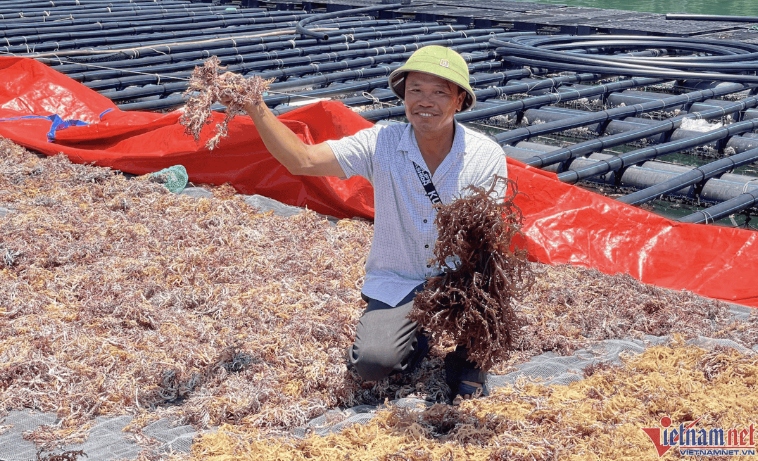Vietnam to exploit seawwed reserves, a giant carbon reservoir
Society – Economy - Ngày đăng : 12:01, 22/09/2024

Vietnam has identified 800 seaweed species, of which 90 species have high economic value. Many large-scale seaweed cultivation areas have arisen, where seaweed and other types of seafood such as oysters and abalone are cultivated.
Cultivated seaweed is used to make food and is the material for the pharmaceutical and cosmetics industry. Many enterprises produce bioplastic cups from seaweed.
Seaweed can be extracted to collect many compounds used in dentistry or food industry. In dairy production, for example, extracts from seaweed can be used to create viscosity in milk, according to Nguyen Thi Sam, CEO of Wineco Vietnam.
In large-scale aquaculture areas such as Quang Ninh, Khanh Hoa, Ninh Thuan and Kien Giang, fishermen growing seaweed can earn billions of dong a year. Seaweed cultivation is the livelihood of many households.
Dinh Xuan Lap, deputy director of the International Center for Aquaculture and Seafood Exploitation, said scientists have found that seaweed can absorb CO2 2-5 times higher than forest plants with the same area.
Some broad-canopy algae, such as kelp, have about 20 times the CO2 absorption capacity of forest trees. One square kilometer of seaweed farming can store 1,500 tons of CO2. Therefore, expanding seaweed farming areas will create huge carbon sinks for the aquaculture industry.
Some species of seaweed have a large canopy and CO2 absorption capability 20 times larger than forest plants. With every one square kilometers of seaweed cultivation, 1,500 tonnes of CO2 can be stored. Therefore, expanding the seaweed growing area will create giant carbon containing reservoir for the seafood sector.
“We are joining forces with enterprises to deploy a program on developing Vietnam’s seaweed area called Blue Ocean – Blue Foods, with an aim of creating a CO2 absorption sea,” Lap said.
Blue Ocean is hoped to help increase CO2 absorption from the ocean, while Blue Foods aims at reducing greenhouse gas emissions in food production, responsible business, as well as creating a sustainable livelihood for fishermen in coastal areas.
The report of the General Directorate of Fisheries (GDF) showed that Vietnam’s potential seaweed growing area could be up to 1 million hectares, which can produce 600,000-700,000 tonnes of dry seaweed each year.
Some seaweed species have been found having a CO2 absorption capacity 20 times higher than plants on land; while other species, after being extracted to make cosmetics and pharmaceuticals, will leave residue which can be used as animal feed, helping reduce methane output.
In agriculture, seaweed is a green material that helps cleanse the ocean, atmosphere and brings high income to people as the required initial investment is not high.
Currently, Vietnam can collect 150,000 tonnes of seaweed a year. GDF head Tran Dinh Luan said once seaweed develops and obtains a certain area, Vietnam will work with international organizations so that seaweed growers can sell carbon credits.
According to Luan, the sale of carbon credits from seaweed farms in other countries has been mentioned. As for Vietnam, selling carbon credits from seaweed is also feasible.
Amid the countries’ commitments on reducing greenhouse gas emissions, carbon credit market has great potential, expected to have the value of US$50-US$100 billion by 2030. According to PTI newswire, global carbon credit demand is about 58 billion credits per annum.
Vietnam has transferred forest carbon credits at US$5 per credit. The World Bank has pledged to pay US$10 for every rice carbon credit. Meanwhile, some international organizations have said they want to buy carbon credits at US$20-US$30 per credit.
Under the latest version of the draft plan on developing the Vietnamese carbon credit market, the carbon market will be developed on a trial basis nationwide in 2025-2028, while an official market will run from 2029.
For the time being, agencies are building a legal framework and infrastructure to serve connection of domestic and international carbon markets.
If Vietnam expands the seaweed farming area by 1 million hectares as expected, it will create a huge source of blue carbon credits. Once the carbon market becomes operational, the underwater carbon containing area will serve as a new natural resource that helps Vietnamese farmers improve their incomes.
